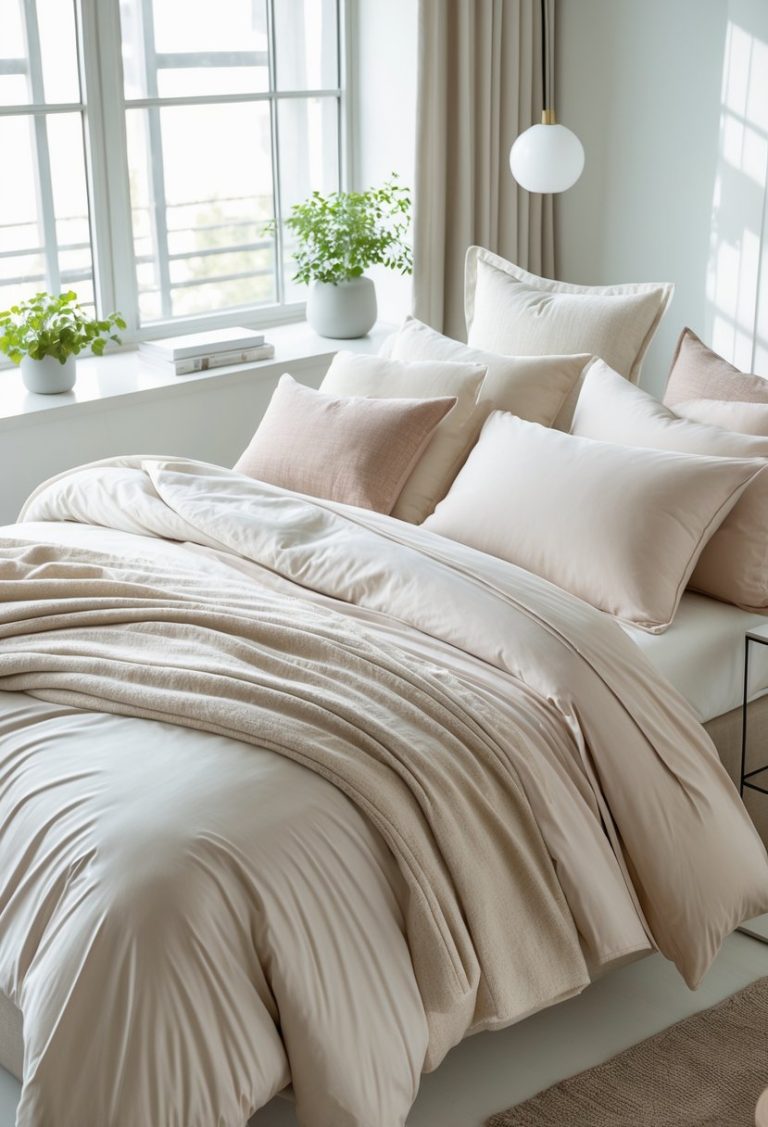How to Style Bedding for a Modern and Cozy Bedroom Look
Styling your bedding can change the whole feel of a bedroom without much effort. I’ve learned that the key is layering different textures and choosing pieces that work well together. The best way to style bedding is to combine a clean base with cozy layers like pillows, throws, and a bed skirt to create a polished, inviting look.

Using simple steps like picking the right duvet or bedspread and adding cushions gives your bed a stylish edge. It’s not about having the most expensive items but about arranging what you have so it looks neat and welcoming. I’ll share easy tips that help you transform your bed into a focal point that feels both comfortable and well-designed.
Choosing the Right Bedding Elements
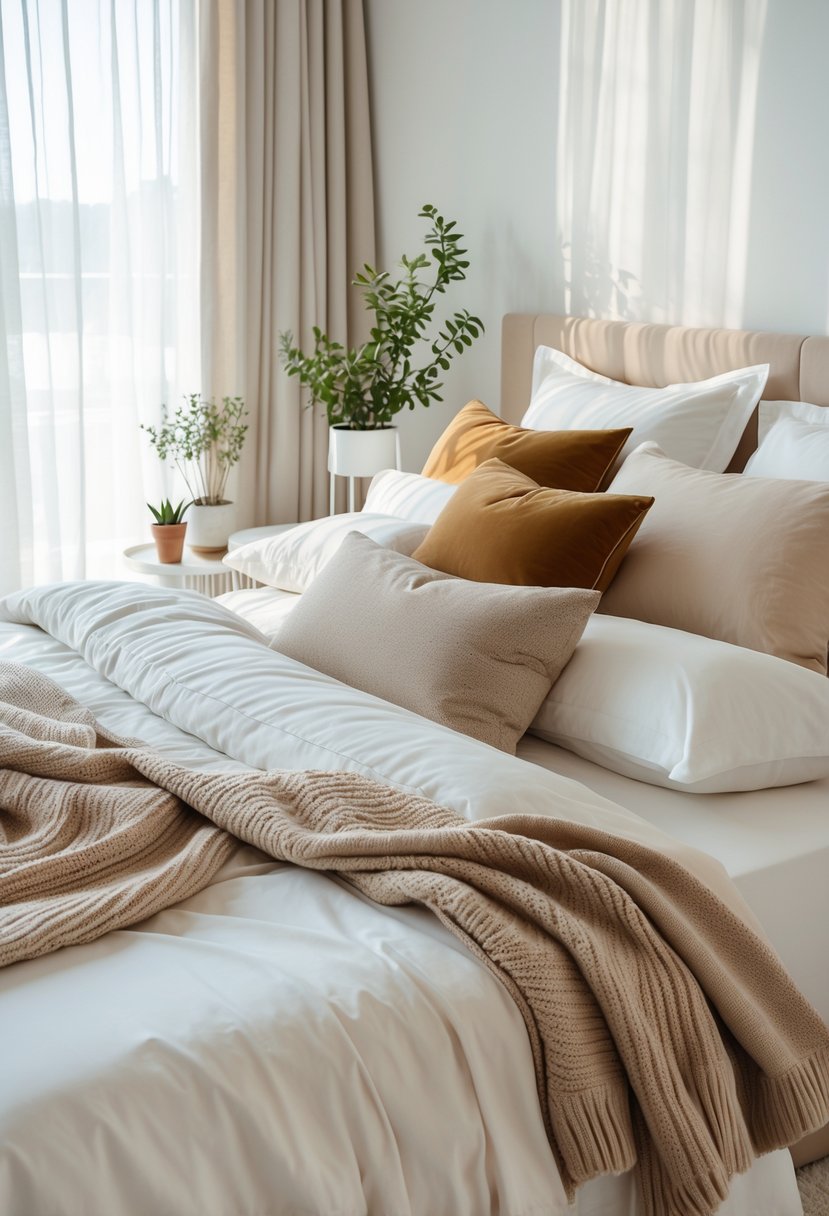
Choosing the right bedding means picking materials and styles that work together for comfort and look. I focus on sheets and pillows, the duvet or comforter, and extra layers like blankets or throws to get the right balance of function and style.
Selecting Sheets and Pillows
Sheets set the foundation for your bed’s comfort and appearance. I recommend choosing cotton for its breathability and softness. Percale weave offers a crisp feel, while sateen feels smoother and shinier. Thread count matters, but I find 200-400 to be the sweet spot for durability and comfort.
Pillow choices affect both support and style. I prefer filling options like memory foam or down alternatives for neck support. Using a mix of firm and soft pillows offers both function and aesthetics. Pillowcases should match or complement your sheets in color and texture.
Picking Duvets and Comforters
The duvet or comforter is the main layer for warmth and visual impact. I select duvets with quality down or synthetic fills based on temperature needs. Down works well for cold climates but synthetic fills handle moisture better.
When choosing a duvet cover, I look for durable fabrics that are easy to clean, like cotton or linen. The color or pattern should match the room’s style. Comforters offer an all-in-one solution but may weigh more. I weigh warmth and ease of care when deciding which to use.
Layering Blankets and Throws
Blankets and throws add texture and extra warmth. I use lighter options like linen or cotton throws for spring and summer. In colder seasons, wool or flannel blankets work best.
I also layer for style by mixing different colors and patterns. A chunky knit throw on top of a smooth duvet adds depth and interest. These layers can be functional for warmth or purely decorative to create a finished look.
Coordinating Colors and Patterns
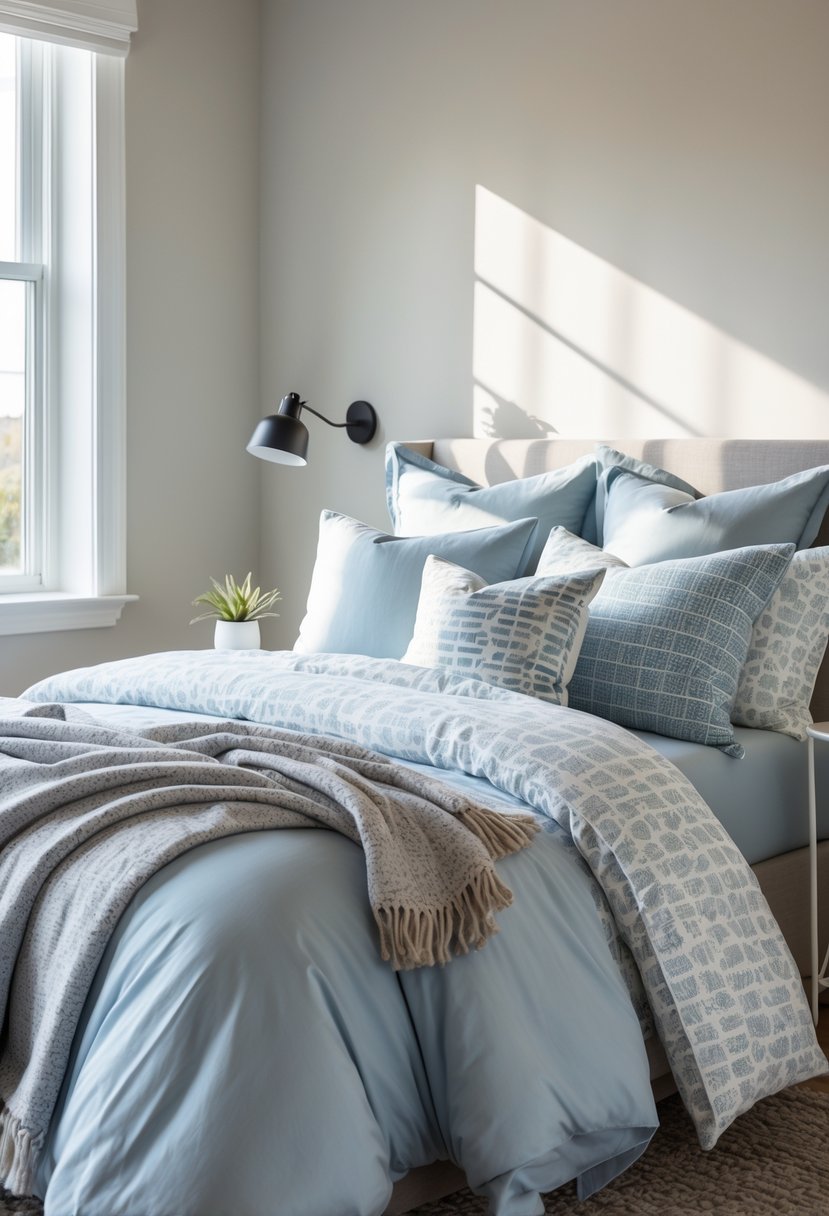
Choosing the right colors and patterns for bedding can change how your bedroom feels. I focus on picking shades that work well together, mixing patterns for balance, and adding textures to keep things interesting. Each part plays a key role in making bedding look stylish yet comfortable.
Matching Color Palettes
I start with a base color that matches the room’s walls or furniture. Then, I pick two or three other colors that complement it. Using a color wheel helps me find shades that go well, like blues with grays or soft pastels with whites.
For example, a navy blue duvet with light gray sheets and white pillows creates a calm, unified look. I avoid too many bright colors at once to keep the bed from looking chaotic. Instead, I choose one bold color and balance it with neutrals like beige or cream.
Using a limited palette also makes it easier to add other decor later without clashing. I keep the bedding colors soothing to make the bed inviting.
Combining Patterns Effectively
Mixing patterns is about balance. I pick one larger pattern as the main focus, like big florals or broad stripes. Then, I add smaller, simpler patterns to support it, such as thin stripes, dots, or subtle checks.
I avoid using patterns that are too similar because they can blend together and look messy. Different scales work best: a big pattern paired with smaller versions makes the design clear and interesting.
I also use color to tie patterns together. If one pattern is mostly blue and white, I look for a second pattern with those colors but a different design. This stops the bed from feeling too busy or confusing.
Incorporating Textures
Texture adds depth without needing more color or pattern. I like to mix smooth fabrics, like cotton sheets, with plush textures such as velvet pillows or knit throws. The contrast between soft and slightly rough textures makes the bed more inviting.
Adding textures also helps when the color scheme is simple. For instance, white bedding with a chunky knit blanket or a quilted cover can make the bed feel warm and full.
I usually avoid all slick or shiny fabrics, because that can feel cold. Instead, I look for cozy, tactile materials to make relaxing easier. Textures must match the style but still offer variety for visual interest.
Styling Techniques for a Polished Look
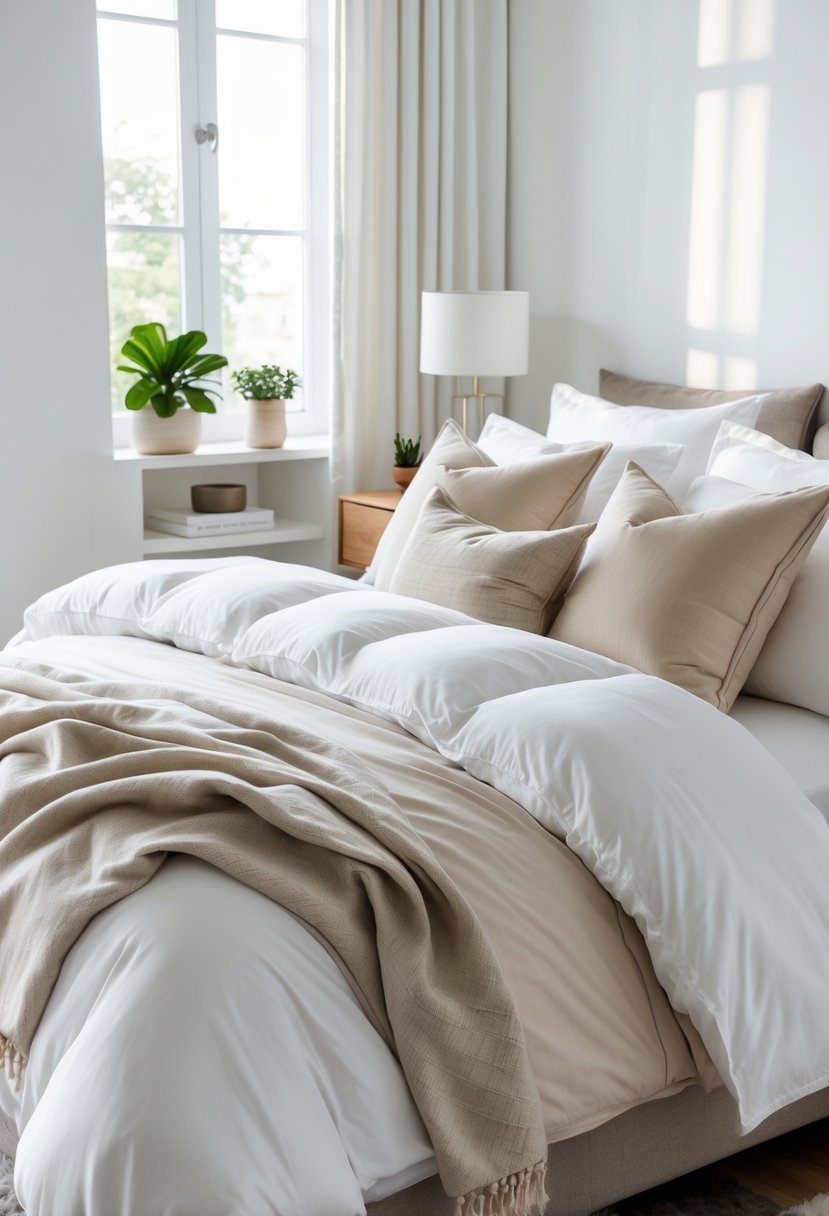
To make your bed look neat and stylish, focus on how you arrange pillows, layer bedding, and fold or drape blankets. Each of these steps helps create a balanced and inviting bed.
Arranging Pillow Layouts
I start with the largest pillows at the back, usually shams or Euro pillows. These create height and act as a frame. In front of those, I add standard or queen-size pillows, then smaller decorative pillows.
A good rule is to keep the tallest pillows at the back and the smallest at the front. I use pillows with different textures or patterns, but I keep colors matching or complementary. This layering adds depth without looking messy.
I make sure pillows are fluffed and symmetrical to keep the bed looking tidy. Mixing shapes, like squares and rectangles, helps create visual interest without clutter.
Creating Layered Bedding
Layering bedding means adding multiple pieces like sheets, a mattress topper, quilts, duvets, and throws. I always start with soft, breathable sheets as my base. On top, I add a mattress topper for comfort and a quilt or coverlet for texture.
Next, I place a duvet or comforter in a color that fits the room’s palette. Layering creates warmth and design interest.
I recommend using different materials and weights for layers. For example, a cotton quilt with a soft wool throw adds richness.
Folding and Draping Tips
The way you fold or drape blankets changes the bed’s look. I like to fold a throw blanket neatly across the foot of the bed. It adds color and invites you to use it.
When folding duvets or comforters, I fluff them up instead of smoothing them flat. This creates a cozy, relaxed feel.
If I use a quilt, I sometimes drape it casually over one corner or side, breaking up the flat surface. Careful draping balances style and comfort in a simple way.
Hotel Style Bedding

I find that hotel style bedding relies on using high-quality materials that feel soft and breathable. Choosing cotton or linen sheets with a high thread count can make a big difference in comfort.
Layering is key to getting a hotel look. I start with fitted and flat sheets, then add a plush duvet or comforter that’s slightly larger than the bed for a neat overhang. This adds a cozy and elegant touch.
Pillows are not just for sleeping but also for style. I use several pillows in varying sizes and textures. Arranging them neatly and mixing firm and soft options creates a balanced, inviting look.
Using neutral colors like whites, creams, and soft grays helps keep the bedding looking fresh and calm, just like in a luxury hotel. I add simple patterns or subtle textures to avoid plainness without overwhelming the space.
Here’s a quick checklist I follow:
- Sheets: High thread count, breathable fabrics
- Duvet: One size larger than the mattress
- Pillows: Multiple, layered by size and firmness
- Colors: Neutral tones with soft accents
Finally, folding the duvet at the foot of the bed or layering a light blanket can make the bed appear well-styled and comfortable. Small details like these give the bed a polished, hotel-like finish.
Farmhouse Style Bedding
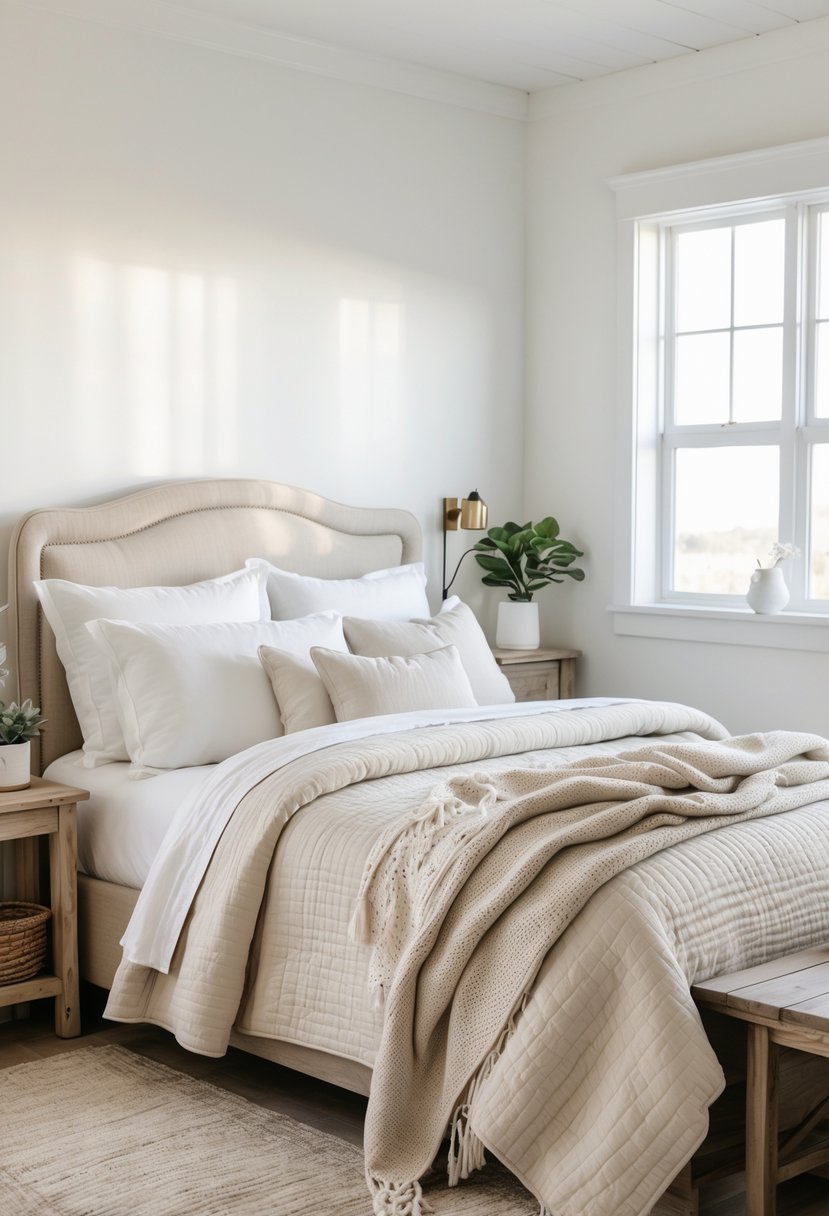
Farmhouse style bedding blends comfort with a simple, rustic charm. I like to start with neutral colors like cream, white, or soft grey to create a calm base. These colors make the room feel clean and inviting.
Layering is key in farmhouse bedding. I add textured throw pillows and cozy blankets at the foot of the bed. This makes the bed look warm and welcoming without being too busy.
Patterns can vary, but I often choose classic checks, stripes, or subtle florals. These patterns give a lived-in feel, which is essential for the farmhouse look. Combining different textures like linen, cotton, and wool adds extra depth.
To style the bed, I follow these steps:
| Step | Description |
|---|---|
| Start with a base | Use a neutral duvet or quilt as your main layer |
| Add pillows | Mix different pillow sizes with soft covers |
| Layer blankets | Place a throw or blanket at the end for warmth |
| Use natural tones | Stick to earth tones for a cozy vibe |
I avoid bright colors and overly modern designs because they break the farmhouse feel. Instead, I focus on comfort and simplicity, which are the heart of this style.

